

 The South African
The South African
B A Friedman (2017)
Introduction
The use of naval forces to augment traditional land forces during times of war or unrest has been standard practice for centuries. This led eventually to the formation of specialised Marine units. Marines have become synonymous with amphibious operations worldwide and have gained a reputation for courage and valour.
South Africa, with its extremely long coastline, would seem to be a country where amphibious capabilities would be important as it would allow for speedy deployment anywhere along the coast. The sea route along the South African coast also remains one of the busiest in the world especially in terms of oil and the strategic value that this commodity presents. Despite this, the South African Navy has always been under financial constraints, affecting its ability to fully guard and protect the coastline. Over the years, various Marine units have been established to satisfy different needs. This article will focus on the period 1979 to 1990 and the history of 1 Marine Brigade that was established during this period by the South African Navy.
Bush War scenario
The South African Defence Force (SADF) was involved the ‘Bush War’ from the early 1970s to the end of 1998. Forces were deployed in Namibia, and various pre-emptive operations were undertaken into Angola to deter the SWAPO infiltration of Namibia. Invariably, this led to clashes against Angolan forces, and later Russian and Cuban forces.
Fidel Castro realised in 1988 that serious intervention would be needed to ensure victory for the Cubans in Angola and/or a negotiated settlement to ensure an honourable extraction of the Cubans. The Cold War was coming to an end and funds and support for Communism were waning.
Thus, the scenario in August 1988 was that the elite Cuban 50th Division was positioned at Techipa, with the SADF planning several operations to counter this threat. The operation finally approved was code-named Prone. In short, Prone planned an eastward flanking movement by the SADF’s 10th Division, allowing the Cuban 50th Division to invade Namibia and then engaging the Cubans on the open plains of the area. The planning also included various other guerrilla tactics, unconventional warfare, and a full amphibious operation.
An army marches on its stomach, and the Cubans were no different. The 50th Division was mainly supplied through the Angolan port of Namibe. Destruction and damage to this port, its facilities as well the airport, would thus seriously hamper the efforts of the 50th Division. This would allow the SADF to attack a weakened and under-supplied force.
Offensive amphibious capabilities
Establishing, training and maintaining amphibious capability is a capital-intensive expenditure for any military establishment. As the Bush War dragged on, the SADF realised that such a capability could be valuable. The South African Special Forces, especially 4 Reconnaissance Regiment, were leaders in this type of operation and had been operating very successfully along the Angolan and Mozambican coasts for several years in conjunction with the South African Navy.
In the 1980s, 1 Marine Brigade came into existence, attempting to fulfil the amphibious role as well as numerous other roles assigned to it by the SADF. Budget restrictions limited the expansion of the Marines and the SADF decided to cross-train paratroopers in an amphibious role to augment the limited capabilities of the Navy. Identified for this role and tasked with amphibious cross-training was 44 Parachute Brigade.
Project Teljoy was registered in 1987 and planning and training commenced with various exercises and planning sessions held in conjunction with the Navy and the Amphibious Boat Squadron (ABS) of 1 Marine Brigade. Thus, during 1988, when the SADF required an intervention to seriously hamper the supply chain of the 50th Division, South Africa had the theoretical capabilities to plan and execute the biggest amphibious operation in its history.
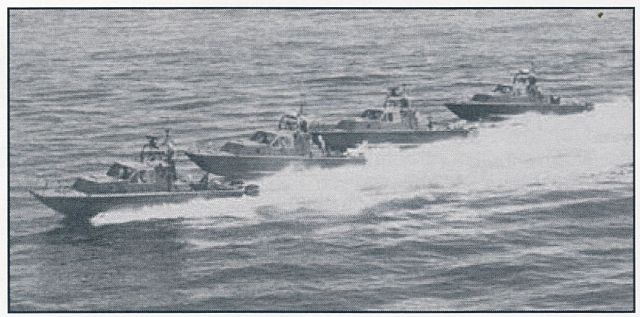
The Marines trained in a counter-insurgency role
to ensure the protection of National Key Points
and commercial harbours.
Operation Kwêvoël was the designated name for the raid on Namibe Port and it entailed the following resources: SAS Tafelberg, SAS Drakensberg, SAS Protea, six strike craft, two submarines, two minesweepers, four Puma helicopters, four C130 aircraft, four C160s, four Ferret anti-tank light armoured cars, fourteen Jackals Jeeps, 256 Para-troopers (Parachute drop), about 700 Paratroopers (Amphibious), a Marine Amphibious Company (MAC), eight D80 Landing Craft, as well as light and heavy infantry equipment, ammunition and weapons.
During 1988 and 1989 the peace process gathered momentum and the various operations that were planned were eventually all shelved. Operation Kwêvoël would have been a definitive and ground-breaking operation in the sphere of amphibious operations. Despite only being able to field a MAC, coxswains, landing craft, boat crews and beachmasters, 1 Marine Brigade would have played a pivotal role in the operation.
Historical timeline
The SA Navy was tasked in 1975 with the responsibility of protecting South Africa’s harbours and ports as well as the National Keypoints within these establishments. Initially, it was decided to allocate the Harbour Protection Task to the SA Navy Citizen Force (CF). In 1978 this programme was rolled out and CF members were called up for training. The first such course was conducted at Saldanha and subsequent courses at Durban and Walvis Bay. The Marine motto, ‘All the Way’ was penned in 1979 by Lieutenant L J G Fourie.
Harbour protection training was then centralised at SAS Simonsberg in Simon’s Town, utilizing the eastern area of the Gunnery School. Lieutenant- Commander A J Duguid was appointed as the first Marine Officer. Using elements of the Gunnery School and the SA Navy Provost Section, training of the Citizen Force continued and was then expanded to include National Servicemen. At the end of 1980, well over 3 000 men had completed a three-week harbour protection training course.
Due to the growing needs of the SADF and the escalation of the Bush War, 1980 saw the Marine Branch begin a rapid transformation from a SA Navy Citizen Force Harbour Protection Platoon concept, to a full-scale Counter-Insurgency (COIN) Infantry Company concept. This transformation included the deployment of one modular Marine Infantry Company to the South West African (Namibian) operational area in December 1980. Initially, the company was deployed to Sector 10 and the base was named SAS Makalani.
After completing his brigade level staff-course, Commander N J Potgieter, Senior Staff Officer Counter-Insurgency (COIN) at SA Navy Headquarters, played a pivotal role in formalising this policy with his ‘OPSPLAN MYLPAAL 80’, dated July 1980.
The SA Marines’ COIN role was summarised as follows: The landward and seaward protection of National Key Points and Commercial Harbours against insurgent attack; the protection of specific SA Navy installations; operational service in South West Africa in support of the SA Army (Rural COIN Operations); and support to the SA Army and the SA Police in the suppression of unrest (Urban COIN Operations).
With the Marine role now considerably expanded to include conventional COIN operations in South West Africa, the Marine School at SAS Simonsberg was closed. This was to allow the officers and instructors to undergo nine months’ infantry training at the SA Infantry School in Oudtshoorn and three months’ operational deployment in South West Africa. This ensured that military skills and standards were completely compatible with the SA Army. They were to form the nucleus of the command/instructor element of 1 Marine Brigade and its Marine Training Wing.
During the closure of the Marine School, SA Navy National Servicemen, called up for the January and July 1980 intakes, were trained at 6 South African Infantry Battalion (6 SAI) in Grahamstown and at 3 SAI in Potchefstroom respectively. They became known as Alpha and Bravo Marine Companies. Alpha Company completed their counter-insurgency phase at Middelburg before deployment to South West Africa (Namibia), as Protection Company to Sector 10 Headquarters Base at Oshakati. They were the first Marine National Servicemen and were granted the right to wear SA Navy badges on their berets by Chief of the SA Navy (a right previously reserved only for Petty officers and above).
In December 1980, Chief of Naval Staff Operations, after visiting SAS Saldanha’s Military Area, decided to establish 1 Marine Brigade HQ and the Marine Training Wing in what used to be the African Compound buildings, and to use the farm area for Marine training.
On the evening of 18 January 1981, Oshakati was shelled from a range of about 8 km north of the base, receiving nine 122 mm rockets. The Marine Company Commander, Lieutenant (later Commander) C C Bloom, was the only armed person. Sentry duty was accomplished by handing the only loaded magazine from sentry to sentry throughout the night. That night was spent in soaking rain.
One section of Marines was identified to undergo a ten-day crash course in 81 mm and 60 mm mortars.
The following month, whilst practising roadblocks north of Oshakati, the Marines captured the SWAPO Platoon Commander responsible for the shelling. This led to further clashes between the SA Army and insurgents, resulting in 48 SWAPO insurgents killed, sixteen captured, and two 122mm rockets confiscated. An element of the Marines, under the command of Lieutenant André Meyer, did recovery operations in Angola under the auspices of the South African Army.
Alpha Company returned, on 10 April 1981, to a new Marine Training School at SAS Saldanha to receive their Pro Patria Medals before being transferred to SA Navy Base Durban for harbour protection and Urban COIN Operations.
January 1981 saw the birth of Charlie Company. These were the first Marines to be fully SA Navy- trained. Their pre-operation counter-insurgency evaluation phase was carried out at Oshivello in Namibia. There they achieved high praise from South African Army evaluators.
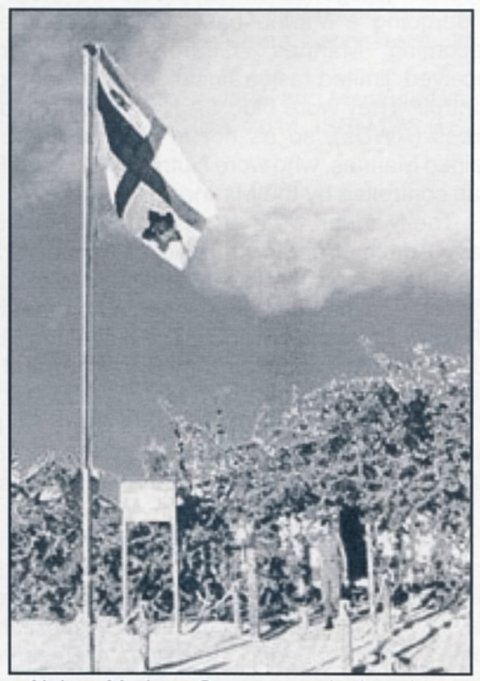
Alpha Marine Company, deployed as protection company
at Sector 10 HQ Base, Oshakati.
Delta Company came from the SA Navy’s July 1981 National Service intake. Delta Company commenced Marine Training in September 1981. They were ready for operational deployment by the end of February 1982.
On 6 December 1981, Lieutenant-Commander Duguid, who had just completed a brigade-level staff duties course at the SA Army College, was officially reappointed as Officer Commanding 1 Marine Brigade.
During 1982 the training wing was taken over by Lieutenant-Commander (later Commander) D H ‘Ysterman’ van Niekerk and 1 Marine Brigade Headquarters, as well as the Marine Training Wing, was moved back to Simon’s Town’s Gunnery School. This year also saw the approval of the Marine Branch crest and Marine Branch non-substantive badges, giving the Marines a clear identity within the SA Navy, boosting morale and esprit-de-corps. A Marine Breast Badge (seen below), approved in line with the other flotillas, could be worn by Marines once they had passed the basic Marine Course.
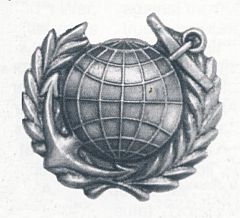
Marine Breast Badge
Marines not only wore the black beret with a Navy cap badge but were also issued with black boots. They were also allowed to colour their web belts black once they had qualified as Marines.
The Marines were also granted the long sought- after water-borne operational task on the Zambezi River at Katimo Mulilo. The base was called Wenela Base and reported to Sector 70. They adopted Whisky, a Labrador, as the official mascot of 1 Marine Brigade. Lieutenant-Commander van Niekerk obtained approval for ‘Sarie Marais’ as the official Marine March/Song.
On 14 February 1983, Commander (later Captain) M St J Thomson took over as Officer Commanding 1 Marine Brigade from Lieutenant- Commander Duguid, who left the SA Navy to later join Special Forces’ 4 Reconnaissance Regiment.
Under the auspices of the Marine Boat School, based in Simon’s Town, the Marine Amphibious Boat Squadron came into being under the command of Lieutenant (later Commander) Bloom. The Amphibious Boat Squadron (ABS) was officially established as a separate wing of 1 Marine Brigade on 5 March 1985. This was occasioned by the need to increase the Navy’s amphibious capabilities. The Marines were equipped with D80 Landing Craft, manufactured in South Africa. These landing craft could carry up to eighteen soldiers and were designed to be launched from the SAS Tafelberg and SAS Drakensberg. A Marine Amphibious Company (MAC) was also formed to be able to secure a beachhead and provide offensive amphibious capabilities. The Marines also commenced the training and development of beachmasters.
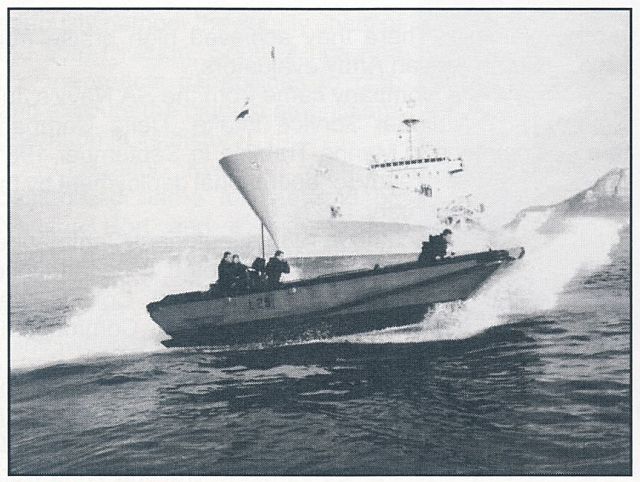
The Marines’ D80 Landing Craft could carry up to eighteen soldiers.
In addition to the normal operational deployment, a special Marine Company was formed to operate along the Sector 20 border in South West Africa. This was in support of the SA Army Operation ‘Bloedrooi’ in 1985. Marines were additionally deployed on urban patrols in Katimo Mulilo.
During 1985 and 1986, Marine officers passed the SA Army Combat Team and Combat Group courses, officially earning SA Army combat status. The Marine companies adopted the names Viking, Eagle and Trident and Marines were attached to SA Army Group 40 and SA Army Group 10.
The Marine Training Wing started Junior Leader Training in Simon’s Town, with a final module at Dolphin Base Sector 20, South West Africa. Previously, all Marine Junior Leaders had been trained in Oudtshoorn at the Army Infantry School. The new intensive training lasted a full year.
Marine officers had to undergo not only the full rigorous infantry training but were also trained in Gordon’s Bay at the Naval Academy. The first ‘Vasbyt’ was conducted for five days from Grabouw towards Kommetjie during the winter months in atrocious wet and gale force conditions.
Other highlights during these formative years included the construction of additional barracks for the Marines at Scala, participation in the Swiss Army March, the Marine Rugby Team winning South African Navy Rugby Week for several consecutive years, the appearance of SA Marine warfare publications, SANOPS and SABRS, the renaming of Harbour Protection Units as Marine Detachments, and Commander Thomson’s promotion to the rank of Captain.
Project Teljoy was established in 1987 to expand the SADF’s need for an offensive amphibious capability. This project was specifically aimed at expanding the SA Army’s amphibious capability using airborne troops. The Army already had a fully functioning parachute brigade with light and easily transportable equipment and the next logical step was to cross-train these paratroopers for an offensive amphibious role.
Exercise Sand Pebble at Saldanha in April 1987 was the first of several highly successful amphibious exercises conducted by the Navy and Marines in conjunction with the Paratroopers. The Navy would be responsible for seaward operations, the Marines to secure the beachhead and beachmaster organisation, and the Paratroopers the offensive capability.
Operation Kwêvoël was planned for 1988, but owing to the constraints discussed previously, this operation was put on hold and the South African Navy conducted Exercise Magersfontein in the Walvis Bay area. A full operational rehearsal was conducted for Operation Kwêvoël and code-named Exercise Strandloper. Reports indicated that this was a very successful exercise and one of the first and biggest in the history of the SADF.
Operation Kwêvoël never got the final nod of approval as a political settlement was reached. However, the Navy and 44 Parachute Brigade conducted another successful exercise in the Saldanha Bay area in 1989. It was code-named Vlakwater and formed part of a larger Naval exercise called Grand Slam.
Also in 1988, Commandant E Wesselo of 7 Infantry Division was transferred to the SA Navy (Reserves), with the rank of Commander, to serve as Senior Staff Officer Marines (Reserves) on the Staff of Director Naval Resources. The Marines (Reserves) could boast a formidable 5 000 trained men.
During 1988 the Marines created a sub-branch, which was called the Guard Force. The Guard Force consisted of National Servicemen with medical categories which precluded them from undergoing a Marine basic training course and becoming Marines. Guard Force members received ‘limited task training’ in entry and egress control. They wore blue SA Navy Action Working Dress (AWDs), so as not to confuse them with trained Marines, who wore Nutria. The Guard Force was controlled by the Marines.
The Marines were disbanded in 1990 (vide C Navy Admin Order 2/90 dated 23 January 1990), The Guard Force, however, continued to exist and, after several name changes, settled on the title of SA Navy Protection Branch. The last of the Marine Junior Leaders completed their training and held their Passing Out Parade in March 1990.
On 13 October 1993, elements of the SA Navy Citizen Force, which included large numbers of SA Navy Marine Reserves, were transferred, as part of the national strategy, to army commando units in the areas where they lived country-wide (vide C Navy VSH/C/101/1 dated 13 October 1993). Despite the large numbers transferred, the SA Navy was still able to call up and field more than a company of Marines in the SA Navy Reserves to form Marine platoons countrywide, in support of the national elections in 1994. The SA Navy Marines were, again, to receive high praise for their professionalism.
The names of the SA Marines who died in service between 1980 and 1990 are inscribed on the SA Navy Memorial situated at the south end of the SA Medical Services Centre in Main Road, Simon's Town. Commemorated here are Seaman (Marine) D J Meyer, Seaman (Marine) H J Kemp, Able Seaman (Marine) V E B de Klerk and Seaman (Marine) F B Els.
Conclusion
In attempting to answer the question as to whether Marines were sentries or Vikings, it is important to note that 1 Marine Brigade came into being as a Protection Force and, at the end of the Bush War, they reverted to being sentries. The interim years are, however, important. The Marines, within the limited budget of the Navy, managed to create a professional multi-dimensional force with a high esprit de corps.
Their application, ranging from serving as Coxswains on the Namacurra class patrol boats, to effecting amphibious landings, to conducting urban and rural COIN operations, was perhaps a prelude to the modern soldier of today who is trained in several disciplines, allowing their deployment in several different military applications. By analysing exercises such as ‘Magersfontein’, as well as the planning of Operation ‘Kwêvoël’, it becomes clear that the Marines had a definitive role to play and were regarded by the planners as instrumental in executing their strategies.
Although history and past events conspired against the Marines to obtain battle colours in the true sense of the word, they were trained and ready to be called upon, if not as Vikings, then as Vikings in the making, carrying their motto ‘all the way’.
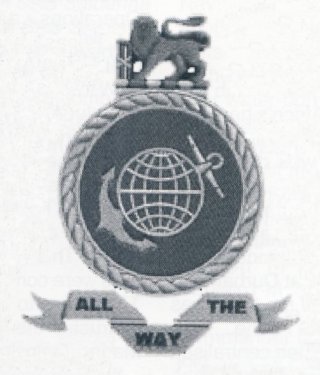
BIBLIOGRAPHY
Books
Bennet, C, South Africa Naval Events Day-by-Day, 2011 (Naval Heritage Trust, Simon’s Town, 2011, ISBN 978 0 620 43014 2).
Harris, C J, War at Sea (Ashanti Publishing, Rivonia, 1991, ISBN 874 800 16 2).
Söderlund A, and Steyn, D, Iron Fist from the Sea (Jonathan Ball Publishers, Johannesburg, 2018, ISBN 978 1 86842 777 2).
De Vries, R, Eye of the Firestorm (Naledi Printers, Tygervalley, 2015, ISBN 978 0 9921912 5 2).
Van der Waag, I, A Military History of South Africa (Jonathan Ball Publishers, Jeppestown, 2015, ISBN 1 86842 418 4).
Rice, A, South African Naval and Maritime Badges and Insignia (A Rice, 2014, ISBN 978 0 620 63443 4).
Articles and periodicals
Dickens, P, 2018, ‘Remembering a South African killed in the Vietnam War’, Online Blog: The Observation Post, accessed 13 October 2018.
Fourie, D, ‘The South African Corps of Marines’ in Military History Journal, Vol 1 No 1, December 1967.
Manganyi, C, ‘Resurrection of the Marine Capability in the SA Navy: The Maritime Reaction Squadron’ in Scientia Militaria, Vol 40, No 3, 2012, pp 429 – 471.
McGill Alexander E, ‘Amphibious Operations – SADF capabilities and plans at the end of the southern African “30-year war”’ in SAMHSEC Newsletter 127, April 2015, Eastern Cape Branch of the South African Military History Society.
Articles and periodicals (cont.)
Navy News: June 1982; 1984 Vol III No 1, pp 9 -12; 1984 Vol III No 8; 1984 Vol III No 9; 1985 Vol IV No 1; 1986 Vol IV No 8; 1986 Vol V No 9; 1987 Vol VI No 7; 1987 Vol VI Sept; 1987 Vol VI Oct; Oct 1989, p 13; Dec 1989, pp 12 -13; Vol XXXII No 3, 2013, pp 17 -19.
Paratus: August 1984, p 17; December 1985, pp 4-6; October 1989, p 42; June 1988, pp 6-7; April 1989, p 10; March 1990, p 34.
Scope, Sept 1988.
Scholtz, L, ‘The South African Strategic and Operational Objectives in Angola, 1987-88’ in Scientia Militaria, Vol 38, No 1, 2010, pp 68 – 98.
Wessels, A, ‘Die Suid-Afrikaanse Vloot: Verlede, hede, toekoms, Deel 1: ‘n Kort kritiese evaluering’ in Scientia Militaria, Vol 11, Nr 3, 1981, pp 9 – 19.
Other sources
Duguid J, ‘History of the SA Marines’ (The author has a collection of material from serving in 1 Marine Brigade during the 1980s).
King, S, Commander (Ret), SA Marines, personal communication, January 2019.
McGill Alexander, E, ‘The Airborne Concept in the South African Military, 1960 – 2000: Strategy versus tactics in small wars’, thesis, University of South Africa, Pretoria, 2015.
McGill Alexander, E, Major General (Ret), personal communication with author, January 2019.
Smith, F, Lieutenant Commander (Ret), SA Marines, personal communication, December 2018.
Wesselo, E, Commander (Ret), SA Marines, personal communication, November 2018.
Return to Journal Index OR Society's Home page
South African Military History Society / scribe@samilitaryhistory.org